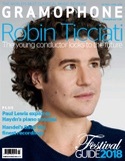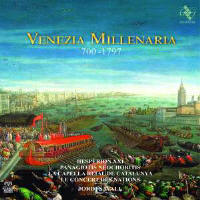Texte paru dans: / Appeared in: |
|
|
Outil de traduction (Très approximatif) |
|
|
Reviewer:
Alexandra Coghlan ‘Venezia Millenaria’ is an extraordinary project – proof of what ambition, imagination and, yes, public subsidy can achieve. From the gorgeous printed book (an actual book, not a booklet) with its abundance of historical images and essays by John Julius Norwich and Judith Herrin among others, to the meticulously researched and often newly arranged tracks, drawing together performers from many different traditions and nations, no expense is spared here in realising this enormous idea in all its richness and variety: telling the history of Venice from 700 to 1797 through music. Imagine walking through the streets of Venice as centuries slip away around you. Through an open window you might overhear a young noblewoman singing a flirtatious song by Hasse; as you pass an Orthodox church the sound of chanting, ancient as the lagoon itself, leaks out; you pass through a curtained doorway into a tavern where folk musicians from Greece and Armenia are playing their traditional dances. This is the disconcerting experience of listening to a recording whose eclecticism mirrors that of the crossroads-city that is its inspiration. Savall and his Hespèrion XXI and Le Concert des Nations are joined here by La Capella Reial de Catalunya, an Orthodox choir and soloists on instruments including the oud, duduk, santur and qanun. The result is a chronological musical mystery tour, whose juxtapositions and collisions are often startling. Plunging from the primal ululations of Byzantine or Russian Orthodox chant (whose shared musical roots are amply evident here) into the highly worked sinfonias of Gabrieli or Vivaldi’s church music is disorienting but throws up shared points of reference too. The syncopated rhythms that pulse through Willaert’s villanesca Vecchie letrose are echoed in the traditional Ottoman dance that follows, and the stile concitato repetitions of Monteverdi’s Combattimento (heard here in full – the most substantial work on the recording) recall the thrumming insistence of the Berber music that precedes it. The characterful instrumental playing of Savall and his colleagues is reflected throughout in the vocal numbers, where colour and drama are prized above beauty, singers captured as though overheard by an anthropologist rather than engineered by a producer. The effect is wonderfully immediate – a snapshot not just of a city but of a spirit of music-making that Savall has pioneered. Many decades since he first began, Savall may have spawned a new generation of imitators, but this musical original is still showing us all how it is done. |
|




